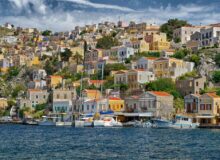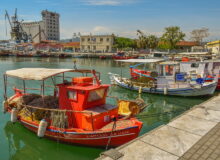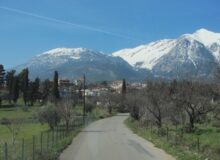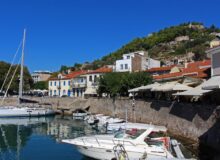Ancient Avdira
See Greece visits the archaeological site of Ancient Avdira (or Abdera) in Western Thrace near the Nestos Valley.

The Archaeological Site of Ancient Avdira in Thrace
Introduction
Nestled in the region of Thrace in northeastern Greece, the city of Ancient Avdira (Greek: Άβδηρα) is an archaeological site of great historical significance. Known for its rich cultural heritage, Avdira flourished as a prominent Greek polis (city-state) during the Classical and Hellenistic periods. The site offers valuable insights into the political, economic, and artistic life of ancient Thrace, as well as its interactions with neighboring Greek colonies and indigenous Thracian tribes.
Historical Background of Ancient Avdira
Founding and Early History
Ancient Avdira was originally founded by colonists from the Ionian Greek city of Klazomenai (in Asia Minor) around the mid-7th century BCE. According to myth, the city was named after Abderus, a companion of the hero Heracles, who was said to have been killed by the man-eating horses of Diomedes, a Thracian king.
The city’s strategic location near the mouth of the Nestos River and its proximity to the Aegean Sea made it an important trade and cultural hub. Avdira quickly grew into a prosperous center, minting its own coins and engaging in commerce with other Greek cities and Thracian tribes.
Classical and Hellenistic Periods
During the 5th century BCE, Avdira reached its zenith, particularly under the influence of the nearby island of Thasos, which controlled several colonies in the region. The city became known for its intellectual contributions, most notably as the hometown of the philosopher Democritus (c. 460–370 BCE), the father of atomic theory.
In the 4th century BCE, Avdira came under the control of the Macedonian kingdom, first under Philip II and later his son, Alexander the Great. The city continued to thrive during the Hellenistic period, maintaining its autonomy while benefiting from the broader cultural exchanges of the era.
Roman and Byzantine Periods
Under Roman rule, Avdira remained an active urban center, though its importance gradually declined due to shifting trade routes and regional instability. By the Byzantine era, the city had diminished in significance, and it was eventually abandoned, likely due to barbarian invasions and economic decline.

Archaeological Discoveries
Urban Layout and Architecture
Excavations at Avdira have revealed a well-organized city with a typical Greek urban plan, featuring:
– Agora (Marketplace): The heart of public life, where political, commercial, and social activities took place.
– Temples and Sanctuaries: Dedicated to Greek deities such as Apollo and Dionysus, reflecting the city’s religious practices.
– Defensive Walls: Remnants of fortifications indicate the city’s need for protection against invasions.
– Residential Areas: Houses with courtyards and mosaic floors showcase the daily life of Avdira’s inhabitants.
Notable Finds
– Pottery and Inscriptions: Numerous ceramic artifacts, including imported Attic vases, highlight trade connections.
– Coinage: Avdira minted its own silver and bronze coins, often depicting mythological figures and local symbols.
– Sculptures and Reliefs: Marble statues and funerary stelae provide evidence of artistic development.
– Tombs and Burial Customs: Both Greek and Thracian burial practices have been identified, indicating cultural exchange.
The Necropolis
One of the most significant aspects of Avdira’s archaeology is its extensive necropolis. Excavations have uncovered a variety of burial styles, including:
– Cist Graves: Simple rectangular tombs lined with stone slabs.
– Macedonian-Type Tombs: Elaborate vaulted structures resembling those in northern Greece.
– Cremation Urns: Reflecting Greek funerary traditions.
These findings suggest a blend of Greek and Thracian influences in death rituals.

Cultural and Intellectual Legacy of Ancient Avdira
Beyond its material remains, Avdira is remembered for its contributions to philosophy and science. Democritus, one of the most influential pre-Socratic philosophers, developed his theories on atomism here. His work laid the foundation for modern scientific thought, emphasizing that all matter consists of indivisible particles (atoma).
The city also appears in historical records as a place of learning and debate, attracting scholars and thinkers from across the Greek world.
Modern Exploration and Tourism at Ancient Avdira
Systematic excavations at Avdira began in the 20th century, led by Greek archaeologists. Today, the site is open to visitors, offering a glimpse into the life of an ancient Greek colony in Thrace. The nearby Archaeological Museum of Avdira displays many of the artifacts uncovered at the site, including pottery, jewelry, and sculptures.
How to Get to Avdira
The archaeological site of Ancient Avdira (Άβδηρα) is located in the region of Eastern Macedonia and Thrace in northeastern Greece. Reaching the site requires some planning, as it is slightly off the typical tourist path. Below are the best ways to get there by car, public transport, or organized tours.
1. Location of Ancient Avdira
The ruins of Avdira are situated near the modern village of Avdira (Άβδηρα) in the Xanthi regional unit, close to the Nestos River Delta and the Aegean Sea.
– Nearest Major Cities:
– Xanthi (50 km north)
– Kavala (70 km southeast)
– Alexandroupoli (100 km east)
– Thessaloniki (220 km southwest)
2. How to Reach Avdira
A. By Car (Recommended Option)
The most convenient way to visit Avdira is by renting a car, as public transport options are limited.
From Thessaloniki (2.5–3 hours)
1. Take Egnatia Odos (A2 Highway) east toward Kavala/Xanthi.
2. Exit at Chrysoupoli and follow signs for Avdira via National Road 2.
3. Pass through Nea Kessani and continue toward the coastal village of Avdira.
4. The archaeological site is signposted near the modern village.
From Kavala (1–1.5 hours)
1. Drive west on National Road 2 (E90) toward Xanthi.
2. After ~50 km, turn right toward Nea Kessani and follow signs for Avdira.
From Xanthi (45 min–1 hour)
1. Take National Road 2 (E90) south toward Kavala.
2. Before reaching Nea Kessani, follow signs for Avdira.
Parking: Free parking is available near the archaeological site.
B. By Public Transport (Limited Options)
Since Avdira is a small village, public transport is infrequent. The best approach is to take a bus to Xanthi or Kavala and then a taxi.
From Thessaloniki
– Take a KTEL bus to Xanthi (~3 hours).
– From Xanthi, take a taxi to Avdira (~50 km, ~€50–€70 one way).
From Kavala
– Take a KTEL bus to Nea Kessani (~30 min).
– From Nea Kessani, take a taxi to Avdira (~10 km, ~€15–€20).
Note: Check KTEL schedules in advance, as buses may not run frequently.
C. By Organized Tour
Some travel agencies in Kavala, Xanthi, or Thessaloniki offer guided tours to Avdira, often combined with visits to:
– Maroneia (another ancient Thracian city)
– Nestos River Nature Reserve
– Porto Lagos (a scenic lagoon)
Check with local tour operators for availability.
Tips for Your Visit to Ancient Avdira
✅ Best Time to Visit: Spring or autumn (milder weather, fewer tourists).
✅ Wear Comfortable Shoes: The site involves walking on uneven terrain.
✅ Bring Water & Sun Protection: Limited shade available.
✅ Combine with Nearby Sites: Consider visiting Maroneia or Mesembria for a full ancient Thrace experience.

Conclusion
Ancient Avdira stands as a testament to the dynamic interactions between Greek colonists and Thracian populations. Its archaeological remains provide valuable information about urban development, trade, and cultural exchange in the northern Aegean. As research continues, Avdira’s legacy as a center of philosophy, commerce, and artistry remains an essential chapter in Greece’s historical narrative.
For historians and travelers alike, a visit to Avdira offers a fascinating journey into the past, where the echoes of Democritus’ atomic theories and the bustling life of a once-great city still resonate.





















